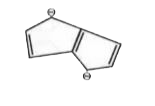Which of the following is a the most preferred and hence of the lower energy for SO3?




The correct Answer is:A
To determine the most preferred and lowest energy structure for sulfur trioxide (SO₃), we need to calculate the formal charges for the different resonance structures of SO₃. Here’s a step-by-step solution:
Step 1: Identify the Valence Electrons
- Sulfur (S) has 6 valence electrons.
- Each oxygen (O) has 6 valence electrons, and there are three oxygen atoms.
- Total valence electrons = 6 (from S) + 3 × 6 (from O) = 24 valence electrons.
Step 2: Draw the Lewis Structures
- The most common Lewis structure for SO₃ has sulfur in the center with three oxygen atoms bonded to it.
- Each S-O bond is a double bond in the most stable structure.
Step 3: Calculate Formal Charges for the First Structure
1. For Sulfur (S):
- Valence electrons = 6
- Non-bonding electrons = 0 (all are involved in bonding)
- Bonding electrons = 12 (6 bonds, each counted as 2)
- Formal charge = Valence electrons - Non-bonding electrons - (Bonding electrons / 2)
- Formal charge = 6 - 0 - (12 / 2) = 6 - 0 - 6 = 0
2. For Each Oxygen (O):
- Valence electrons = 6
- Non-bonding electrons = 4 (2 lone pairs)
- Bonding electrons = 4 (2 bonds)
- Formal charge = 6 - 4 - (4 / 2) = 6 - 4 - 2 = 0
Step 4: Calculate Formal Charges for the Second Structure
1. For Sulfur (S):
- Valence electrons = 6
- Non-bonding electrons = 2 (one lone pair)
- Bonding electrons = 6 (3 single bonds)
- Formal charge = 6 - 2 - (6 / 2) = 6 - 2 - 3 = 1
2. For Each Oxygen (O):
- Valence electrons = 6
- Non-bonding electrons = 6 (3 lone pairs)
- Bonding electrons = 2 (1 bond)
- Formal charge = 6 - 6 - (2 / 2) = 6 - 6 - 1 = -1
Step 5: Compare the Formal Charges
- In the first structure, all atoms have a formal charge of 0.
- In the second structure, sulfur has a formal charge of +1 and two oxygens have a formal charge of -1.
Conclusion
The first structure, where all atoms have a formal charge of 0, is the most preferred and has the lower energy.
Final Answer
The most preferred and hence lower energy structure for SO₃ is the one where all formal charges are zero.
---
- Sulfur (S) has 6 valence electrons.
- Each oxygen (O) has 6 valence electrons, and there are three oxygen atoms.
- Total valence electrons = 6 (from S) + 3 × 6 (from O) = 24 valence electrons.
- The most common Lewis structure for SO₃ has sulfur in the center with three oxygen atoms bonded to it.
- Each S-O bond is a double bond in the most stable structure.
1. For Sulfur (S):
- Valence electrons = 6
- Non-bonding electrons = 0 (all are involved in bonding)
- Bonding electrons = 12 (6 bonds, each counted as 2)
- Formal charge = Valence electrons - Non-bonding electrons - (Bonding electrons / 2)
- Formal charge = 6 - 0 - (12 / 2) = 6 - 0 - 6 = 0
- Valence electrons = 6
- Non-bonding electrons = 4 (2 lone pairs)
- Bonding electrons = 4 (2 bonds)
- Formal charge = 6 - 4 - (4 / 2) = 6 - 4 - 2 = 0
1. For Sulfur (S):
- Valence electrons = 6
- Non-bonding electrons = 2 (one lone pair)
- Bonding electrons = 6 (3 single bonds)
- Formal charge = 6 - 2 - (6 / 2) = 6 - 2 - 3 = 1
- Valence electrons = 6
- Non-bonding electrons = 6 (3 lone pairs)
- Bonding electrons = 2 (1 bond)
- Formal charge = 6 - 6 - (2 / 2) = 6 - 6 - 1 = -1
- In the first structure, all atoms have a formal charge of 0.
- In the second structure, sulfur has a formal charge of +1 and two oxygens have a formal charge of -1.
The first structure, where all atoms have a formal charge of 0, is the most preferred and has the lower energy.
The most preferred and hence lower energy structure for SO₃ is the one where all formal charges are zero.
Similar Questions
Knowledge Check
Which of the following is most basic?
A B
B C
C D
D
Which of the following is most polar?
A B
B C
C D
D
Which of the following is most acidic?
ABenzyl alcholBCyclohexanolCPhenolDm-Cholorophenol
